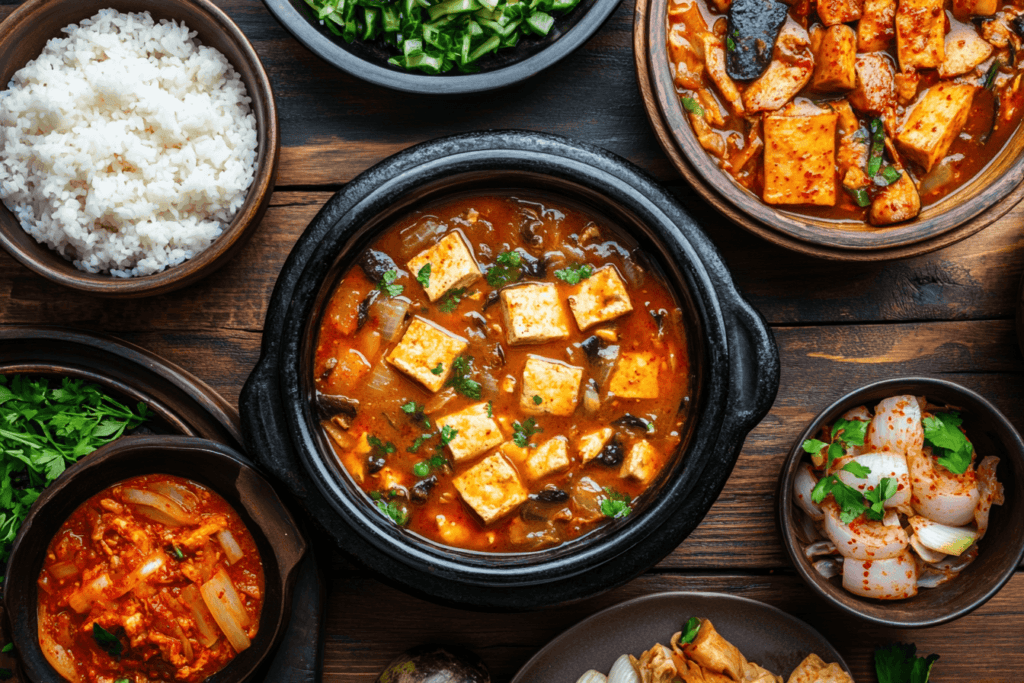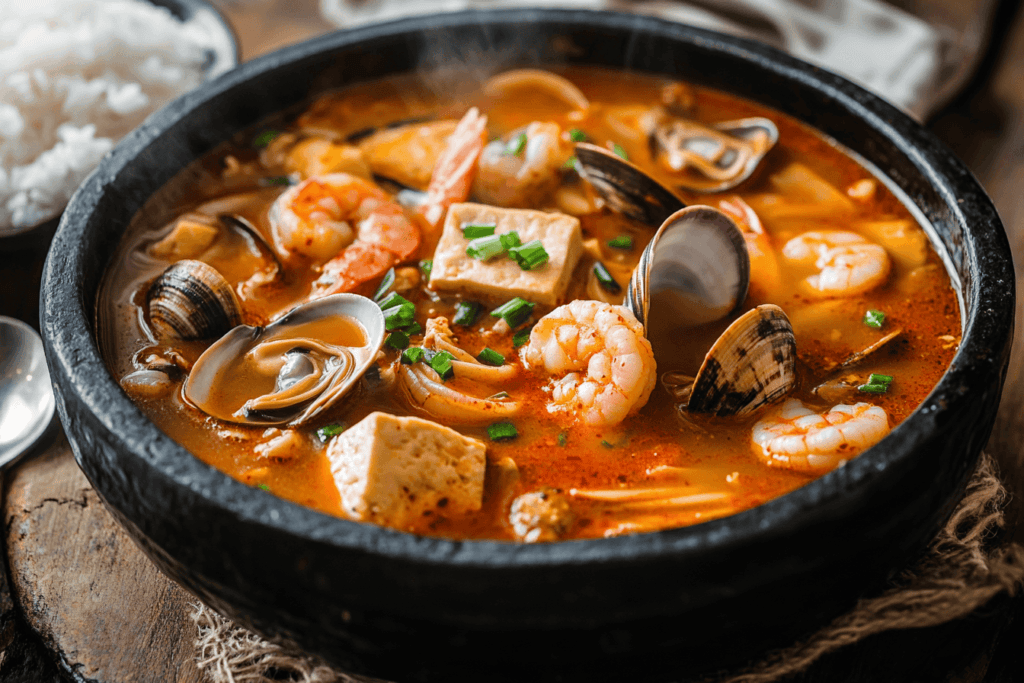
Stews, or jjigae, are a key part of Korean food. Known for their strong flavors and warming nature, they are staples in Korean homes and restaurants. Two of the most loved jjigae dishes are Sundubu jjigae and Kimchi jjigae.
Both stews are served steaming hot and have vibrant red broths. However, Sundubu jjigae is known for its creamy soft tofu, while Kimchi jjigae gets its tangy and spicy taste from aged kimchi.
In this article, we’ll explore what makes these two stews special, covering everything from their origins and flavors to their health benefits and cultural significance. Whether you love Korean food or want to try these dishes for the first time, this guide will help you appreciate their unique qualities.
What is Sundubu Jjigae?
Sundubu jjigae, also called soft tofu stew, is a comforting dish in Korean cooking. People love it for its smooth texture and warm flavors.
History of Sundubu Jjigae
The exact origins of Sundubu jjigae are unclear, but it likely started in Korean monasteries where tofu was a common food. Others think it became popular in coastal areas because fresh seafood and tofu were easy to find.
Modern Sundubu jjigae gained attention in the 20th century, especially in cities. Its simple preparation and flexibility made it a household favorite. Today, it’s not only a home-cooked meal but also a popular restaurant dish worldwide.
Key Ingredients of Sundubu Jjigae
The main ingredient in Sundubu jjigae is sundubu, or uncurdled soft tofu. Unlike regular tofu, it has a silky, custard-like texture.
Other ingredients include:
- Protein: Seafood like clams, shrimp, or squid, or meats such as pork or beef. Vegetarian options use mushrooms or plant-based proteins.
- Broth: A mild broth made from anchovies, kelp, or beef, seasoned with chili powder and soy sauce.
- Vegetables: Garlic, onions, zucchini, and green onions.
- Egg: A raw egg is often cracked into the stew and cooks in the heat.
Cooking Process
Sundubu jjigae is often made and served in a stone pot, which keeps the stew hot throughout the meal. The steps include:
- Sautéing aromatics: Garlic and chili powder are fried lightly to release their flavors.
- Building the broth: Stock and protein are added and cooked.
- Adding tofu: Soft tofu is gently spooned in to keep its texture.
- Final touches: Vegetables, seasoning, and a raw egg are added before serving.
Flavor and Texture
Sundubu jjigae is mildly spicy with a rich, savory flavor. Its soft tofu makes the stew creamy and smooth, while the broth adds layers of umami from seafood or meat.

What is Kimchi Jjigae?
Kimchi jjigae, or kimchi stew, is another favorite in Korean homes. It’s made with aged kimchi, which gives it a bold, tangy, and spicy flavor.
History of Kimchi Jjigae
The history of Kimchi jjigae is closely tied to kimchi, a staple of Korean food for centuries. Originally, Koreans used kimchi as a way to preserve vegetables during winter. Over time, this fermented dish evolved into a key ingredient for various meals, including jjigae.
In the 20th century, Kimchi jjigae gained popularity because it was both affordable and easy to prepare. Today, it stands as more than just a comfort food—it has become a cultural icon that embodies the essence of Korean cooking.
Key Ingredients of Kimchi Jjigae
The main ingredient is aged kimchi, which gives the stew its signature sour and spicy taste. Other ingredients include:
- Protein: Pork belly, canned tuna, or tofu.
- Broth: Water or anchovy stock mixed with kimchi juice for extra flavor.
- Seasoning: Chili paste, chili powder, and sometimes sesame oil.
- Vegetables: Garlic, onions, and mushrooms.
Cooking Process
Kimchi jjigae is made in a simple pot or earthenware bowl. The basic steps are:
- Sautéing the kimchi: This step enhances the flavor.
- Adding stock and protein: The broth and chosen meat or fish are added and cooked.
- Simmering: The stew is simmered until the flavors blend, with tofu or other ingredients added last.
Flavor and Texture
Kimchi jjigae is bold and tangy with a spicy kick. The sourness of the kimchi balances the heat, while pork or tuna adds richness. Crunchy kimchi pieces and soft tofu create a mix of textures that make every bite interesting.
Key Differences Between Sundubu Jjigae and Kimchi Jjigae
While Sundubu jjigae and Kimchi jjigae share similarities as traditional Korean stews, they have distinct differences in ingredients, preparation, flavor, and texture. These differences highlight their unique characteristics and appeal to different preferences.
Ingredients: Sundubu jjigae uses soft tofu as its main ingredient, while kimchi defines Kimchi jjigae.
Broth and Flavor: Sundubu jjigae has a lighter, milder broth, while Kimchi jjigae is tangy, spicy, and richer.
Texture: Sundubu jjigae is creamy due to the soft tofu, while Kimchi jjigae offers crunch from the fermented cabbage and chunks of meat.
Who Should Try Each?
- If you prefer a milder, creamier dish, Sundubu jjigae is an excellent choice. It’s also a great option for seafood lovers or those seeking a soothing meal.
- If you enjoy bold, spicy, and tangy flavors, Kimchi jjigae will likely be your favorite, especially if you already love the taste of fermented foods like kimchi.
Understanding these differences not only enhances appreciation for both dishes but also helps diners choose the jjigae that best suits their mood or taste preferences.

Cultural Significance and Popularity of Sundubu Jjigae and Kimchi Jjigae
Both Sundubu jjigae and Kimchi jjigae are deeply embedded in Korean culinary culture, representing different aspects of the nation’s history, traditions, and dining habits. Their cultural importance has extended beyond Korea, making them global ambassadors of Korean cuisine.
1. Sundubu Jjigae in Modern Korean Dining
- Rising Popularity in Restaurants:
Sundubu jjigae has seen a surge in popularity, especially in Korean barbecue restaurants and casual dining establishments worldwide. Its mild, comforting flavors make it a favorite among diners new to Korean food. - Versatility in Preparation:
Sundubu jjigae’s ability to adapt to various ingredients, from seafood to mushrooms, reflects the dynamic nature of Korean cooking. In modern times, creative versions of Sundubu jjigae, such as those with added cheese or fusion flavors, have appeared in Korean-American communities. - Emphasis on Health:
As people globally seek healthier meal options, Sundubu jjigae has gained attention for its nutrient-dense, low-calorie profile. Its soft tofu base appeals to vegetarians and those looking for plant-based protein options. - Cultural Symbol of Comfort:
For Koreans, Sundubu jjigae evokes a sense of warmth and home. It is often enjoyed during colder months or as a comforting meal during times of stress.
2. Kimchi Jjigae: A Korean Household Staple
- Everyday Meal in Korean Homes:
Koreans often refer to Kimchi jjigae as a ‘go-to dish’ in their households. It is a way to use up leftover kimchi while creating a hearty, satisfying meal. Many Koreans associate Kimchi jjigae with their childhoods, as it is frequently prepared by mothers or grandmothers. - Cultural Representation of Kimchi:
Koreans regard kimchi as the heart of their cuisine, and Kimchi jjigae highlights its versatility. The stew symbolizes the ingenuity of Korean cooking, transforming a humble fermented vegetable into a rich, flavorful dish. - Expression of Regional Flavors:
Regional variations in Kimchi jjigae highlight Korea’s diverse culinary landscape. For example:- Seoul-style Kimchi jjigae tends to be lighter and milder.
- Jeolla-do-style incorporates seafood for a richer taste.
- Icon of Resilience:
Historically, Kimchi jjigae has been a symbol of resourcefulness. During difficult times, it provided a way to make nutritious meals with minimal ingredients, a tradition that continues to resonate today.
3. Global Popularity of Both Dishes
- Hallyu Wave and Korean Food Culture:
The global rise of Korean pop culture, known as the Hallyu Wave, has brought dishes like Sundubu jjigae and Kimchi jjigae into the international spotlight. Fans of Korean dramas often see characters enjoying these stews, sparking curiosity and desire to try them. - Accessibility in Korean Restaurants:
Both dishes are widely available in Korean restaurants around the world. Sundubu jjigae is particularly popular in regions with a significant Korean-American population, such as Los Angeles and New York City. - Appeal to Global Palates:
- Sundubu jjigae’s milder, less spicy profile makes it an excellent introduction to Korean food for those unfamiliar with bold flavors.
- Kimchi jjigae, with its strong and distinctive taste, appeals to food enthusiasts seeking authentic, traditional Korean flavors.
4. Cultural Celebrations Featuring Jjigae
jigae offers more than just nourishment; it plays a central role in cultural celebrations and gatherings. During festivals or family occasions, hosts serve large pots of jjigae to bring people together. Sundubu jjigae is a popular choice for comforting communal meals, while Kimchi jjigae often takes center stage at casual family dinners.
5. Social Media and Culinary Tourism
- Social Media Influence:
Platforms like Instagram and TikTok have amplified the visibility of Korean dishes. Videos of bubbling Sundubu jjigae in traditional stone pots and steaming bowls of Kimchi jjigae have attracted global audiences eager to explore Korean cuisine. - Culinary Tourism:
Tourists visiting Korea often seek out authentic jjigae experiences in local restaurants or traditional markets. Both Sundubu jjigae and Kimchi jjigae are must-try dishes for anyone exploring the country’s food scene.
Both Sundubu jjigae and Kimchi jjigae hold unique places in Korean culture and cuisine. Sundubu jjigae’s creamy, mild profile represents comfort and modern creativity, while Kimchi jjigae’s bold, tangy flavors connect deeply with tradition and resourcefulness. Their growing popularity around the world further cements their status as iconic dishes in Korean and global culinary landscapes.
FAQs
1. Can you add kimchi to Sundubu jjigae?
Yes, you can add kimchi to Sundubu jjigae for a tangy and spicy twist. While traditional Sundubu jjigae doesn’t always include kimchi, it blends well with the soft tofu and light broth, adding extra flavor. For a detailed recipe on crafting a Sundubu jjigae base that can incorporate kimchi, check out Sundubu-jjigae Recipe.
2. Which jjigae is spicier: Sundubu jjigae or Kimchi jjigae?
Kimchi jjigae is generally spicier due to its use of aged kimchi, gochujang (Korean chili paste), and kimchi juice. Sundubu jjigae has a milder spice level, which can be adjusted depending on the amount of chili powder used. Learn how gochugaru and gochujang impact the flavor profile in Sundubu-jjigae Recipe.
3. Can Sundubu jjigae or Kimchi jjigae be made vegan?
Yes, both stews can be made vegan. For Sundubu jjigae, replace seafood or meat with mushrooms and use vegetable broth. For Kimchi jjigae, ensure the kimchi is made without fish sauce or shrimp paste and use tofu or plant-based proteins instead. Get insights into vegan alternatives and ingredient customization in this Sundubu-jjigae guide.
4. Which jjigae is better for colder weather?
Both stews are great for cold weather, but Kimchi jjigae’s bold and spicy flavors make it particularly comforting during winter. Sundubu jjigae, with its creamy tofu and warming broth, is also a popular choice for chilly days. Explore the warming ingredients in Sundubu jjigae in this recipe overview.
5. Are there regional differences in how these stews are made?
Yes, regional variations exist for both dishes. For example, Sundubu jjigae may include different seafood depending on the coastal region, while Kimchi jjigae in Jeolla-do often features seafood, making it richer in flavor. Discover more about how local ingredients influence Sundubu jjigae in this recipe exploration.
Conclusion
Sundubu jjigae and Kimchi jjigae are two beloved Korean stews, each with its own charm. Sundubu jjigae is comforting and creamy, making it ideal for those who prefer milder flavors. Kimchi jjigae, on the other hand, is bold and spicy, perfect for fans of tangy dishes.
Both stews showcase the depth and variety of Korean food, proving that jjigae is more than just a meal—it’s a part of Korea’s culinary story.
